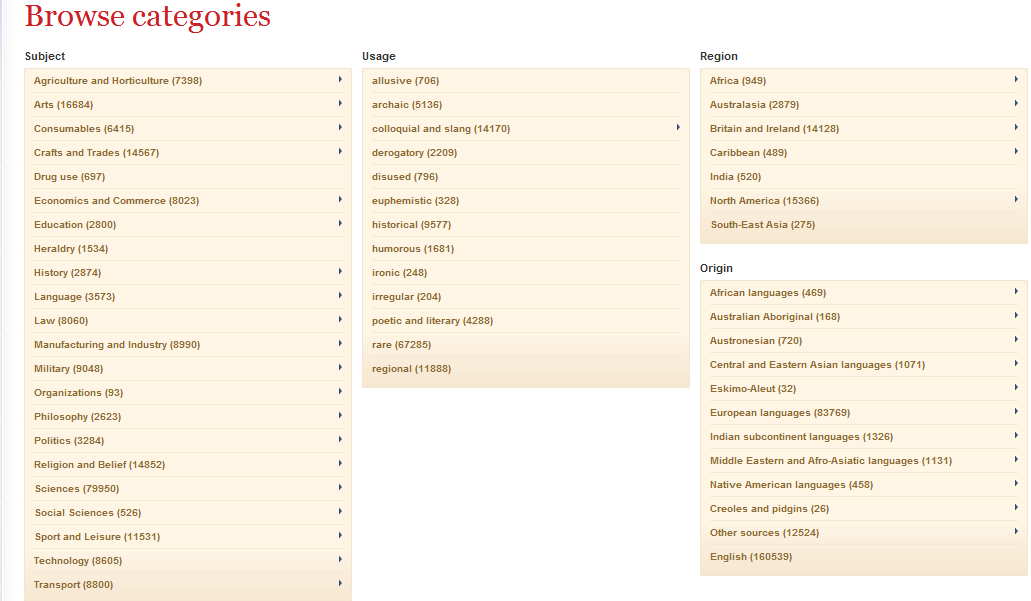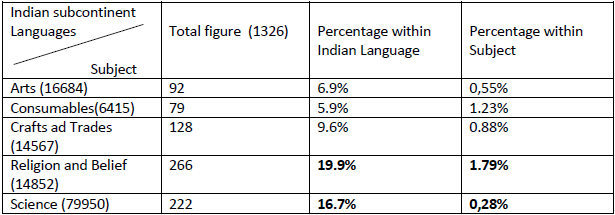Another innovative feature of the OED online is called Categories and aims at classifying each dictionary entry in accordance with its sense. The main page consists of four major categories focusing either on Subject, Language of origin, Usage or Region of the entry word. Each category is again subdivided into up to 22 subtopics. A triangular black arrow after each topic indicates that there are even more sub-points, which are related to each other. In addition, the program offers the possibility to combine all these categories so that nearly every aspect of the word sense can be investigated.
Due to the multiplicity of options described, the main page might appear compact and maybe overloaded or confusing at first sight, but offers very exciting and challenging research possibilities after getting familiar with the structure of the page.

Screen shot 6 Categories
In order to gain a first insight into the numerous possibilities to use this feature for linguistic purposes the following mini project will serve as an example query. As stated, the feature subdivides the word entries into four main categories, which are interrelated. Therefore, it is feasible to investigate the areas of subjects and of origin. In doing so, one could focus on the impact of one or several foreign languages on the vocabulary of different subject areas in the English language. In order to carry out such a project, each of the selected Subject categories needs to be browsed individually. Doing so, a list of all relevant entries pops up. As a further step, the results can in turn be refined. By clicking on language of origin, placed in the right hand column of the page, another smaller list of all relevant languages appears, including their total number of relevant entry words for the selected category. In a last step, a table with all relevant figures can be created. In this particular case, the query focuses on Indian subcontinent languages and their influence on English.

Table 4 Influence of Indian Subcontinent Languages on major subjects in English
Table 4 shows that OED word entries with Indian subcontinent origin can generally be found in all subject areas of the English language analyzed. Nevertheless, percentagewise there is an uneven distribution of Indian subcontinent words among the different subjects. It reveals that the largest numbers of Indian loanwords can be found in the area of Religion and Belief (19,9 %) and also in the area of Science (16,7%). Moreover, the percentage of Indian subcontinent loanwords lies between 9,6-5,9 % in the Subject areas of Crafts and Trades, Consumables and Arts. An influence should therefore still be traceable. All other areas have such a low percentage (2- 0,15%) of Indian loanwords that they can be neglected. Looking at the results, Indian subcontinental languages seem to be of some importance for the English language.
This first impression is altered immediately, when setting these results in relation to the overall number of word entries in any given subject. Extremely low percentages ranging from 0,07% to only 1,79% are the result. Even the two main distribution areas of Indian Subcontinent Languages “Religion and Belief” as well as “Sciences” show no significant influence (1,79% and 0,28%). Both can therefore be classified as insignificant for the subject areas. The findings reveal that the Indian subcontinent languages were (and still are) of minor importance for the shaping of the English language.
In order to extend such a query, it is possible to investigate further languages and compare their influence on the English language or take a closer look at the context or region in which the words are used etc. The only major disadvantage that appeared while conducting this study was that all European languages are grouped in just one sub-category by the OED. As a consequence, it cannot not be determined if a word is, for instance, of French or German origin.
Created with the Personal Edition of HelpNDoc: Easily create EBooks